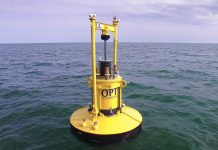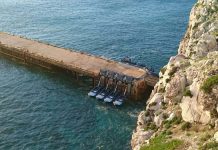Jennifer Runyon
 |
| Powerful Ocean Wave photo via Bigstock |
That was the question posed to industry experts at the EnergyOcean International conference and exhibition that took place in Danvers, Mass., this week. Referring to three levels of development Epoch 1, 2, and 3 Andrew Tyler, CEO of Marine Current Turbines (MCT), a company now owned by Siemens (SI), gave a few key pointers to companies interested getting beyond the “very expensive hobby” stage of ocean energy development.
While his tongue-in-cheek reference to marine and tidal energy development was sarcastic, the sentiment was real. It’s a pricey endeavor. The proof-of-concept stage will run about $1 million, he said. The small-scale stage will run $2 miliion to $5 million and to get to the full-scale prototype stage, a company will need to have $15 million to $30 million at its disposal. Tyler said that for financing companies should look to venture capitalists or government because “banks won’t touch them” since the risk is just too high.
How Can Start-ups Get Funding?
As with all renewable technologies, especially nascent ones like ocean energy, reducing costs is key to advancing the industry. Tyler said in order to attract any financing, technology risks must be as minimal as possible. Even venture capitalists “won’t touch a science experiment,” he said. He encouraged start-ups to focus on sites that will be easy to develop, instead of those that might be the “juiciest” in terms of energy potential. The ocean energy industry could learn from the offshore wind industry, which started going after resources that were easier to tap rather than deepwater sites that are more complicated to develop.
In order to get financing, start-ups must have an unrelenting focus on reducing the levelized cost of energy (LCOE) to the point where it is “at least in line with other renewable energy sources,” Tyler said. He also encouraged those interested in becoming part of the industry to focus on areas down the value chain where they could reduce costs. He told me that he often gets calls from inventors who have a patent but no money and who would like Siemens to invest in them. Once in a while, he said he would take a meeting with them to see if the idea truly is a viable one. And these days, he’s more apt to take those meetings if the inventor has an idea for how to make improvements lower down on the value chain. “There is plenty of room for innovation in the supply chain,” he said.
Partnering with the Big Boys and Reducing Risk
In addition, money for the right technologies can also come from bigger energy companies. Recently Siemens took a majority stake in MCT, showing to the world that it has confidence in the industry. About six months ago global power and automation group ABB (ABB) took a $20 million stake in Greenvolts to help advance its concentrating photovoltaics technology and about a year ago General Electric (GE) purchased small thin-film maker Primestar. Tyler believes that this trend will continue as larger companies look for innovative technologies to build out their portfolios.
Even the most willing investor needs to feel confident that the potential gains outweigh the risks of losing money. The ocean energy industry should also, therefore, focus on lowering the risks associated with investing in its technology.
Amanda Forsythe, a tax attorney with law firm Chadborne and Parke, gave some examples of how the ocean energy industry could help reduce risk. In the U.S., she said, the government hasn’t been able to set a clear course for renewable energy development. Forsythe explained that right now the biggest risk that companies face is the “change of law” risk, i.e., the expiration and non-extension of important tax incentives for developers. She encouraged the industry to lobby for key enabling policies like RPS set-asides or “carve-outs” for certain technologies. For example, if coastal states were to require that a utility meet a small percentage of its RPS with ocean hydrokinetic energy, it would go a long way towards helping the industry get off its feet. She also mentioned feed-in tariffs as a great enabler but pointed out that with the onset of the financial crisis in the EU, FiTs are losing their popularity even in Europe, the region that championed them to begin with. Finally she said that government loan guarantees also help to reduce risk for investors and encouraged the industry to continue to fight for them in the U.S.
 |
| Fabrege Egg photo via Bigstock |
MCT’s Tyler said that by 2020, his company would be building and placing in service 100-MW ocean energy facilities and that electricity costs will be in line with offshore wind. He expects to get there by going into large-scale manufacturing and mentioned plans to build a stand-alone facility in the future.
A large-scale manufacturing facility producing 100-MW ocean energy turbines is certainly more than a hobby. For MCT, which started in 1999 and put its first commercial scale tidal turbine, the 1.2 MW SeaGen, in the water in 2008, the road was long and full of struggles but the payoff producing cost-effective, clean renewable energy for generations to come is worth way more than a huge collection of Faberge eggs.
Jennifer Runyon is managing editor of RenewableEnergyWorld.com and Renewable Energy World North America magazine. She also serves as conference chair of Solar Power-Gen Conference and Exhibition and Renewable Energy World North America Conference and Expo.




